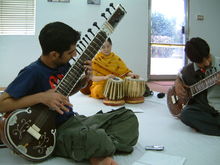The official national sport of Pakistan is field hockey with squash and cricket also very popular. The national cricket team has won the Cricket World Cup once (in 1992), were runners-up once (in 1999), and co-hosted the games twice (in 1987 and 1996). Additionally, they have also won the ICC World Twenty20 once (in 2009), and were runners-up (in 2007). The team has also won the Australasia Cup in 1986, 1990, and 1994.
At an international level, Pakistan has competed many times at the Summer Olympics in field hockey, boxing, athletics, swimming, and shooting. Hockey is the sport in which Pakistan has been most successful at the Olympics, with three gold medals (1960, 1968, and 1984). Pakistan has also won the Hockey World Cup four times (1971, 1978, 1982, and 1994).[6] Pakistan has hosted several international competitions, including the South Asian Federation Games in 1989 and 2004.
A1 Grand Prix racing is also becoming popular with the entry of a Pakistani team in the 2005 season. The Tour de Pakistan, modelled on the Tour de France, is an annual cycling competition that covers the length and breadth of Pakistan. Recently, football has grown in popularity across the country, where traditionally it had been played almost exclusively in the western province of Balochistan. Fifa has recently teamed up with the government to bring football closer to the northern areas too.


